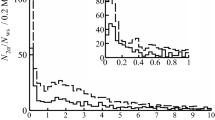Summary
Stacks of 600 μm pellicles were exposed to the 4.6 and 3.0 GeV pion beam of the Berkeley Bevatron. A number of heavy unstable particles and hyperfragments were obtained. The ratio of the frequency of occurrence of K+ and K--mesons has been found to be approximately unity in contrast to the large positive excess in the proton beam. As a possible explanation, it is suggested that the K--meson is produced in conjunction with a K+-meson according to the following reaction: π-+p → K++K-+N. Two hyperfragment decays of hydrogen have been fo nd in which the π--meson stops. One of the hyperfragments was identified as a 41 H* produced by a ⌆--hyperon; the other one is a 31 H* produced directly by the high energy pion. The range of all the charged particles was accurately determined which yielded a reliable value of the binding energy. The value of the binding energy (B.E.) for 31 H* was found to be 1.2 ±0.6 and for 41 H* B.E.(∧0) = 3.3 ±1. The mean free path for nuclear collisions was determined for 5.7 GeV protons and 3 GeV π-mesons. The results yielded for protons 37.6 ±5.3 cm and for π--mesons 35.5 ±5.0 cm. Both mean free paths are longer than the geometrical mean free path for nuclear collisions in the emulsion, which is 25 cm.
Riassunto
Pacchi di pellicole di 600 μm sono stati esposti a fasci di protoni di 4.6 e 3.0 GeV del Bevatrone di Berkeley. Si sono ottenuti un certo numero di particelle instabili pesanti e di iperframmenti. Il rapporto della frequenza di produzione di mesoni K+ e K- è risultato circa 1 in contrasto col grande eccesso positivo nel fascio protonico. Come possibile spiegazione del fenomeno si pensa che il mesone K- sia prodotto in unione con un mesone K+ secondo la reazione π- + p → K+ K- + N. Si sono trovati due iperframmenti da decadimento dell’idrogeno in cui si arresta il mesone π-. Uno degli iperframmenti è stato identificato con un 41 H* prodotto da un iperone ⌆-; l’altro è un 41 H* prodotto direttamente dal pione di grande energia. Il percorso di tutte le parti celle cariche è stato accuratamente determinate, ottenendo un valore attendibile dell’energia di legame. Il valore dell’energia di legame (B.E.) per il 41 H* risulta essere 1.2±0.6 e per il 41 H* B.E.(∧0) = 3.3±1-Il cammino libero medio per le collisioni nucleari è stato determinate per protoni di 5.7 GeV e per mesoni π- di 3 GeV. Si ottenne per i protoni 37.6 ±5.3 cm e per i mesoni π- 35.5 ±5.0 cm. I due cammini liberi medi sono maggiori del cammino libero medio geometrico per collisioni nueleari in emulsione che è di 25 cm.
Similar content being viewed by others
References
M. Gell-Mann and A. Pais: Proceedings of the International Conference, Glasgow (London, 1954)
Author information
Authors and Affiliations
Additional information
Supported in part by a joint program of the U. S. Office of Naval Research and the U. S. Atomic Energy Commission.
Rights and permissions
About this article
Cite this article
Schein, M., Haskin, D.M. & Glasser, B.G. Heavy unstable particles produced in the high energy pion beam of the Berkeley Bevatron. Nuovo Cim 3, 131–140 (1956). https://doi.org/10.1007/BF02746201
Received:
Published:
Issue Date:
DOI: https://doi.org/10.1007/BF02746201



